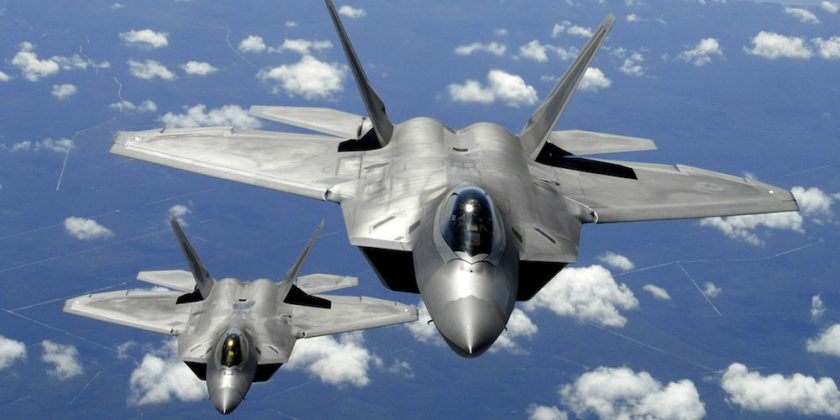The same day news broke that Russia apparently fabricated an interaction between a single U.S. F-22 and three Russian jets over Syria, the Russia Air Force found themselves face-to-face with the real thing: and it didn’t play out quite like they’d imagined.
While CENTCOM was issuing a statement debunking Russia’s account of the first ever intercept of an F-22 by a Russia’s advanced Su-35S, the real thing was taking place over the Euphrates River in Syria, which serves as the “deconfliction zone’s” dividing line between U.S.-backed troops, and Russian-backed Syrian forces. This deconfliction zone was established to ensure American and Russian or Syrian forces did not find themselves engaging one another as the various groups continue operations to combat ISIS throughout the region. Earlier this year, American fighters shot down a Syrian Su-22 as well as two Iranian drones over Syria.
What now appears to be the first ever (actual) interaction between a Russian Su-35 and American F-22s actually began in a similar fashion to the fictional Russian account released earlier this week, with one notable exception: it was a Russian Su-25 close air support aircraft that crossed over the Euphrates, violated the deconfliction zone and failed to respond to American calls for them to return to their own airspace. Two F-22s were scrambled to intercept and ensure the safety of American-backed forces east of the river, and it wasn’t long before their more powerful sibling, the modern Su-35, entered the fray.
The F-22s conducted multiple maneuvers to persuade the Su-25s to depart our de-conflicted airspace, including the release of chaff and flares in close proximity to the Russian aircraft and placing multiple calls on the emergency channel to convey to the Russian pilots that they needed to depart the area,” Air Forces Central Command spokesman Lt. Col. Damien Pickart said.
Pickart went on to say that the Russian pilots demonstrated aggressive and unprofessional behavior, at one point, even forcing one of the F-22As to divert its course to avoid a collision. “One Su-25 flew close enough to an F-22A that it had to aggressively maneuver to avoid a midair collision,” he said.
During the encounter, which lasted a reported 40 minutes or so, a single Su-35 approached the posturing jets, and was immediately shadowed by one of the F-22As. It’s important to note that these two jets are widely considered to be among the most maneuverable dogfighting aircraft in the world, and many have long wondered how America’s more dynamic 5th generation fighter would stack up against Russia’s extremely advanced 4th generation jet.
In Russia’s fictional recounting of such an interaction, a single Su-35 was so daunting a presence, it left the F-22 scrambling to return to U.S.-controlled air space. In Wednesday’s actual encounter on the other hand, it was the three Russian jets that backed down and returned to their own territory.
According to CENTCOM’s statement made prior to this interaction, Russian jets had violated the deconfliction zone no less than nine times on November 23rd alone, which is the date of the supposed Russian interaction on their side of the border with a single American F-22. It now appears that Russia was merely trying to establish their own fictional narrative ahead of a New York Times article drawing attention to their repeated, and flagrant, violations of the deconfliction zone put into place in order to deescalate tensions between the two nations.
It’s interesting the Russians didn’t raise these unfounded allegations until a New York Times article publicly exposed a serious matter the Coalition has tried diligently to address daily via the deconfliction line,” an Air Force official told Business Insider in an email on Tuesday.
“Had an F-22 actually flown across the river into their deconflicted airspace, the Russians would have raised this on the call and it would have been discussed. Coalition deconfliction call transcripts show no such incident ever transpired,” the official said.
Like Russia’s attempt to pass obviously faked video game footage off as evidence of American wrongdoing in Syria last month, it would seem yet another attempt at undermining U.S. foreign policy in the region using fabricated evidence has failed for the Russians, with the added irony of a real interaction between the storied fighters coming so soon thereafter.
Already have an account? Sign In
Two ways to continue to read this article.
Subscribe
$1.99
every 4 weeks
- Unlimited access to all articles
- Support independent journalism
- Ad-free reading experience
Subscribe Now
Recurring Monthly. Cancel Anytime.
Image courtesy of the U.S. Air Force









